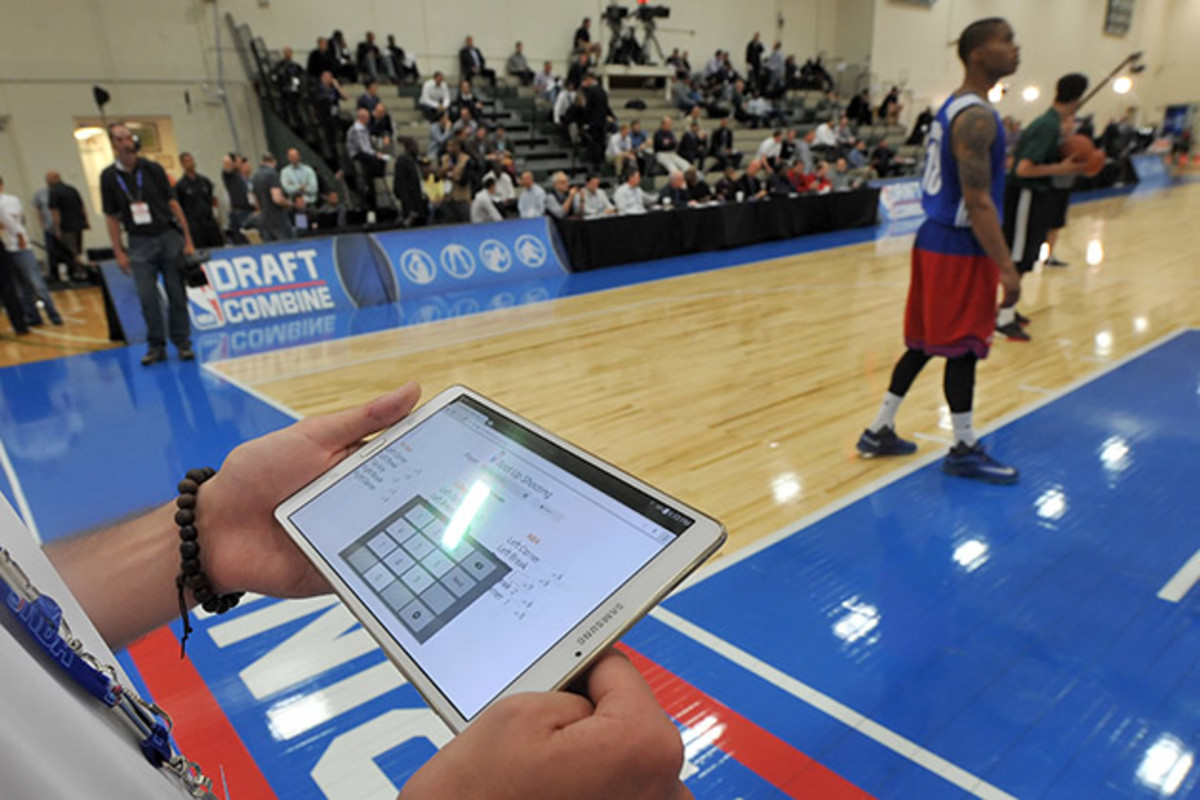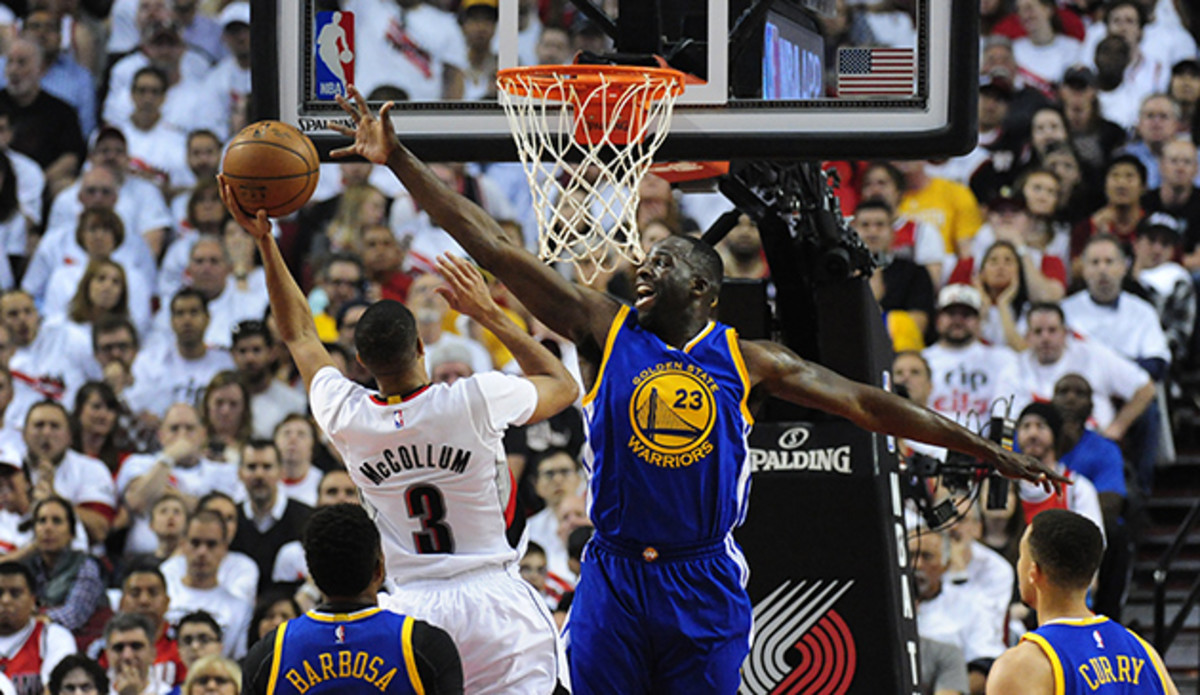Value of the vertical jump: How Combine results relate to NBA success

In the NBA, identifying and drafting talent can make or break the future success of a franchise. Yet despite 10,000-hour rules and advances in genetic testing, talent remains an elusive quality to define and quantify. When looking for the next Steph Curry, LeBron James, or Kevin Durant, is it as simple as looking for the sum of a player's athletic skills? Not quite.
Less publicized than the NFL Combine, the NBA Draft Combine is an annual event that will this year bring over 70 of the best collegiate and international players to a 5-day event in Chicago, with the hopes of identifying talent. Prospects are evaluated in a multi-part process — anthropometric tests (measuring height, weight, standing reach and wingspan), athletic tests (185 pound bench press, lane agility, shuttle run, three-quarter court sprint, standing vertical leap, and max vertical leap), guided basketball drills and 5-on-5 scrimmages. Teams also use the time to interview players and conduct medical assessments.

Mubarak Malik, head strength and conditioning coach for the New York Knicks and a member of the NBA executive committee, believes that the event is important for both the NBA and it’s incoming players.
“For the NBA, it’s an opportunity to display the athleticism of its players,” he says, “For the players at the Combine it’s a great way to get to know the league and gain confidence in their ability.”
But while the Combine gives teams numbers that seemingly depict a participant’s physical skill set, does the event give us all the information needed to accurately measure basketball talent and for that matter, predict future performance?
Here's how you stay fit while traveling, as told by an NBA pro
“LeBron didn't say, ‘I'm taking my vertical jump to South Beach’, because talent is more than just one skill or number,” says Erwin Valencia, director of training and conditioning for the New York Knicks. According to Valencia, one test or even a group of physical tests can’t define an athlete’s talent.
Every sport has prized talents and physical attributes: for baseball, it’s the 95-mph fastball; for the NFL, 40-yard sprint speed; and in the NBA, it’s the vertical jump. But while measures like vertical jump might rank high on attraction, they are lower on predictive usefulness. Even NBA teams don’t appear to value vertical jump as significantly as the highlight reels would have us believe, as three of the top-6 leapers in Combine history went undrafted.
“With the Combine, the NBA and its teams are blurring the lines between skill and physicality,” says Dr. Phil Wagner of SpartaTrac, a force based, basketball analytics system used to quantify performance and injury risk. Teams are increasingly using analytics like SpartaTrac (the NBA uses P3 Sports Science to collect data of this type at the Combine) to conduct their own pre-draft athletic evaluations of players. Wagner makes the point that possessing speed, agility and explosiveness does not necessarily equal success at the NBA level.
What’s more, according Andrea Hudy, the assistant athletic director for sports performance at the University of Kansas, how is just as important as how much. “Athletes that have a high, but slow, force production may perform well on a vertical jump test but not be able to translate that into game time explosiveness.”
“It could be that some of the players with a great vertical jump are able to bank on out-jumping everyone else rather than learning the other immeasurable skills necessary for NBA success,” says Malik.
NBA releases names of draft combine participants
Elite athletic skills like explosiveness, agility and speed are a big part of what has made the athletes at the Combine successful already, but, at the next level, other attributes may differentiate the All Stars from the busts.
So what numbers can we use to predict NBA success? A 2014 study conducted by psychologists Jerad Moxley and Tyler Towne tried to answer that question by reviewing the performances of over 300 NBA Combine invitees from 2001-06. The researchers were interested in whether performance in the NBA is predicted by physical makeup and athleticism while factoring in prior basketball performance. To test the theory that physical size and athleticism are markers of yet to be realized potential, the researchers investigated a number of variables, including age, college performance, player position, college quality, height, agility, no-step vertical leap, arm span, and weight.
From there the researchers tried to predict success in the first three years of NBA performance, a critical period in a young player’s career. The results? Even though physical size and athleticism predicted draft order, the only variables that predicted NBA success were college quality, college performance, and youth.
The study concludes, “To clarify, our argument is that these physical characteristics have already contributed to achievement and training opportunities by the time the player reaches the NBA and thus does not differentiate player class at the professional level.”
Innovation in Hydration: Sweat testing is next level of sports hydration
The bottom line: if possessing those skills and physical size made a player effective in college, then he was more likely to be productive at the next level. Simply possessing great athleticism—the idea of "upside"—without a prior record of performance wasn’t good enough.
“People are looking for something that hasn’t yet been captured by college performance, but the Combine doesn’t measure anything that adds that predictive value,” says Tyler Towne, one of the authors of the study. "We need to get away from measuring general athletic abilities and instead use more specific tests of actual basketball skill.”
It isn’t so much that the tests don’t adequately assess general athleticism. They do. The question is, are the skills measured at the Combine the most relevant for the NBA—for example, is a point guard’s vertical jump relevant for success at his position. “It’s difficult to use athleticism as a gauge since what makes one player great may not be what makes another successful,” emphasizes Wagner.
Those with experience of the combine agree that the value of the event may not lie with the athletic skills portion, rather with the anthropometrics and mental makeup of the athletes. “The general anthropometric [height, weight, standing reach, wingspan] information is some of the most valuable information to come out of the Combine,” says JoHan Wang, a former athletic trainer and strength and conditioning coach for the Warriors and Clippers.
The SI Extra Newsletter Get the best of Sports Illustrated delivered right to your inbox
Subscribe
Wang believes that we are still learning how to use the emerging field of sports science and good teams know how to effectively analyze data from the Combine. “Blending the physical information into an overall profile can shed light on a player’s skill set and potential," he says.

This information gives teams a glimpse into a player’s versatility, especially as a defender. Wang uses the example of Draymond Green, a player that he worked with at the Warriors. At 6’7” he can play much bigger because of his large wingspan and reach—Green's 8’10" standing reach was greater than fellow 2011 Combine participants Drew Gordon, Miles Plumlee, Harrison Barnes and Tyler Zeller, who are all taller than Green.
So while all of those players also outperformed Green’s numbers in the vertical jump, Wang asserts that work ethic and drive—two traits that aren't measured at the Combine—give Green an edge over other players.
“Figuring out which players have those personality traits—through the interviews, personality tests and sports psychologists—may be the real useful part of the Combine,” Wang says. “In fact, character and work ethic have become increasingly more important to NBA teams in the last 10 years.”
